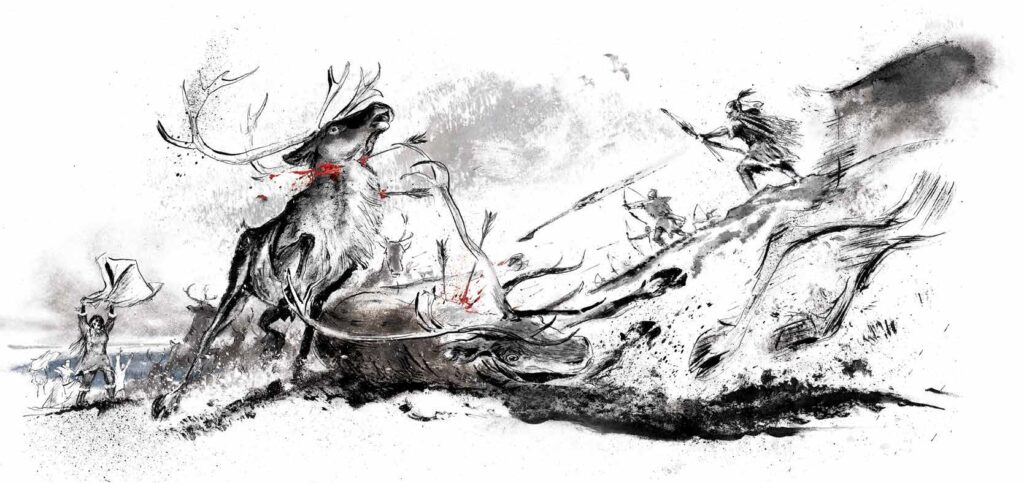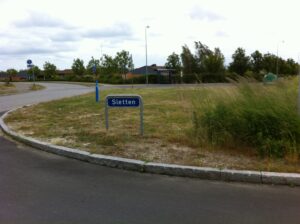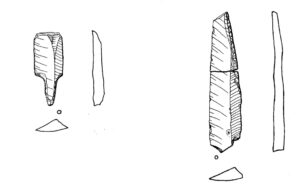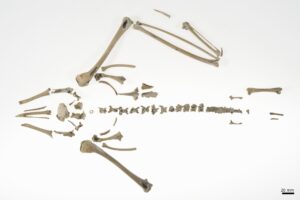Interview: Felix Riede

Felix Riede (@ARCHAEOfelix on Twitter) is faculty member of the Department of Culture and Society at the University of Aarhus, Denmark, and the editor-in-chief of the Danish Journal of Archaeology. Interested in questions of environment, climate and cultural change, Dr. Riede received a Post-Ph.D. Research Grant from the Foundation in 2012 to aid research on ‘Excavation of a Campsite from the Hamburgian Culture Near Krogsbølle, Eastern Denmark’. We reached out to Riede to learn more about this early European hunter-gatherer site and what it can teach us about folkways long vanished from the historical record.
Could you begin by telling us a bit about the project that received WGF funding?
I was so fortunate as to receive a Post-Ph.D. Research Grant from the Wenner-Gren Foundation for a project with the rather unglamorous title Excavation of a campsite from the Hamburgian culture near Krogsbølle, eastern Denmark. Behind this prosaic title hides a very exciting project, however. The iconic so-called Hamburgian culture of northern Europe is associated with the first movement of hunter-gatherer people into the newly deglaciated, desolate and deserted landscapes of northern Europe some time after 12,500 years BCE. How did people cope with moving in regions where the details of the resource distribution were unknown and where the nearest relatives were far away? Foragers are known ethnographically to rely on a range of coping strategies including mobility, storage, economic intensification or diversification as well as social networking to handle such challenges. But questions remain about how exactly these prehistoric pioneers did so. The ethnographic record furnishes an important interpretative frame of reference, but given that we have next to no ethnographic accounts of true pioneer foragers, only the archaeological record can really reveal significant insights about past pioneering behaviors. A final twist to this project rests in the observation that the archaeological culture that follows the Hamburgian in northern Europe has a striking different material culture. It is possible to hypothesize that the Hamburgian disappeared abruptly possibly due to some form of demographic collapse. What is unclear, however, is whether climatic warming or cooling trends played a role in this collapse, and what role fluctuations in the primary resource base of the Hamburgian culture – reindeer – had.

What makes this site unique/interesting?
Sites of the Hamburgian culture are exceedingly rare, especially at the very northern edge of its range. In Denmark, for instance, there really are only four such locales as well as a few and largely uncertain surface finds, and this alone makes Krogsbølle, located on the northern outskirts of the town of Nakskov, interesting and important. In addition, the last time a locale from the Hamburgian culture has been investigated in Denmark was in the 1980s! The site we are now excavating has actually been known for a couple years, but lack of funding has prevented local museum authorities from excavating there. In the meantime, ploughing has continued to damage the site; excavating this important site and recovering the artifact material was one key priority of the project. It is also worth mentioning that preliminary investigations had indicated the possibility of two finds-bearing layers where the lower of the two may preserve intact spatial patterns that reflect activities carried out at the site or even traces of shelters. The preservation of such ‘latent’ patterning is extremely rare in this time period.
What were some of the challenges that presented themselves during the course of this work, and how did you adapt to them?
The main challenge we encountered was that the local soil turned out to be considerably harder than we anticipated. This made it impossible to dig manually through the topsoil and very hard to even carefully excavate the layers beneath. After a few days of trying, we finally decided to switch to a coarser machine-aided approach to strip key areas of topsoil, all in square meters, all of which was dry-screened through 3mm mesh. This was quite laborious and meant that we could excavate rather fewer squares than we had hoped. We did, however, firmly re-locate some of the excavation areas from earlier investigations conducted by the local museum, to retrieve a range of fantastic lithic artefacts, to document the site stratigraphy, and to take samples for dating it.
Of course we also faced the usual trials and tribulations of fieldwork with scorching heat and torrential summer rain. Especially our final day in the field – as always the busiest of all – was cut short by a massive thunderstorm rolling over us. Going around an open field clearly elevated above the general landscape carrying a long rod – to take final levels throughout the excavation field – suddenly seemed like a very bad idea indeed!

So far, what has surprised you the most about the site?
Working with the material from Krogsbølle two main surprises popped up. One relates to the artifacts we recovered. When I took a closer look at them and compared them to material from other sites of this culture, I was struck by an interesting duality of diversity and similarity. Let me explain what I mean: Hamburgian artifacts are really well-made, reflecting highly skilled flint-knappers as well as rather strict conventions about exactly how things should look like. In the periods just after the Hamburgian, we can similarly recognize clear conventions about size and shape of, for instance, projectile points. In the Hamburgian we can single out several projectile point variants, so overall the armatures show a fair bit of diversity. Yet, within these variants, the ways in which these are made are exceedingly similar. They are to all intents and purposes identical – and this has implications both for the organization of craft production, but also for the time scales involved. I am currently considering the possibility that all the Danish sites from this period, for instance, represent no more than one human generation and perhaps much less, as little as a few seasons of occupation. Breaking up an archaeological culture whose overall chronological span is often listed as 500-700 years to the actions and movements of individuals is radical and challenging.
The second surprise came when we conducted some coring in areas around the nearby lake. The wet and waterlogged deposits of such ancient lakes often preserve organic remains either of purely natural or even of human or cultural origin. Natural materials can give important clues about local environments and local environmental changes, whilst finds of organic material such as animal bones or even bone, antler or wooden tools are very rare indeed. Previous investigations by the local museum concluded that no remains of the ancient lake and hence no organic material were preserved there, but we found quite the opposite. Whilst we did not, so to say, hit jack-pot – we did not find any organic materials directly related to the settlement we are excavating – we did find the almost completely preserved skeleton of a seagull. We had this seagull dated by our colleagues of the radiocarbon laboratory at Aarhus University and analyzed for the maternally inherited mtDNA by colleagues at the Centre for GeoGenetics at Copenhagen University. It turns out that the gull is at least as old as the human occupation at Krogsbølle and this makes it not only the by far most complete ancient gull from northern Europe, but also by far the oldest – by several millennia! The genetic investigation has not yet been able to pinpoint the species; it could be one of three: Larus argentatus (the European herring gull), Larus fuscus (the lesser black-backed gull) or Larus glaucoides (the Iceland gull). This work is on-going and we know that some aspects of the gull genome can discriminate between the species. DNA preservation is excellent in our specimen, so I am confident that we can determine its species in due time. At any rate, it will, together with our other investigations of the ample pollen and other plant remains in the ancient lake layers, provide important information about the environment when these pioneering hunter-gatherers rested here.

How has the Danish Heritage Agency reacted to your findings?
As the project progressed the Danish Heritage Agency heard of them and contacted us with an eye towards including the site in one of their dissemination projects. With funding by the A.P. Møller Foundation, the Danish Heritage Agency has embarked upon an ambitious project that takes the museum out into the landscape. The project includes landscaping and restoring selected sites and monuments, and erecting information displays in Danish, German and English. You can read more about this great project here. The local authorities vent along with the proposal and earlier this year we unveiled the information displays as well as a micro-exhibition in the local tourist information center. For the information display they also had an artist make the following ‘dramatic reconstruction’ of the kind of behaviors that may have taken place around the site. Despite its lack of standing architecture and thus its seeming anonymity, Krogsbølle is a great site for this project because it tells such an exciting story and because it is located at a busy cycle path used by both locals as well as tourists day in day out. Unfortunately, the area where the site is located is also, by Danish standards, quite deprived and suffers from steady emigration. We hope that showing how it once was one of the most attractive places to stay, local folks in particular can positively use this bit of cultural heritage.
What’s next for this research? How much work still needs to be done? How could this project or its findings expand in the future?
We have finished excavation for now, but know perfectly well that more material is to be found – both on the dry land as well as in what remains of the ancient lake. We are also still in full swing with the analysis of the stone tools, especially comparing them to another recently excavating Hamburgian site in northern Germany and a rather sensational site from Scotland, far away from the ‘territory’ of the Hamburgian as traditionally conceived. We are also still waiting for the final absolute dates for our stratigraphy (using optically stimulated luminescence – a method to date sand grains) and of the environmental analysis. In the meantime, we are working on a couple of preliminary reports and I am busy presenting our preliminary results at scientific meetings, conferences and, well, on the internet. Luckily, our efforts to attract follow-up funding from some smaller private foundations here in Denmark have been successful, so in principle we could also return to the field in the years to come. The latest chapter that has already begun is that the local authorities are considering building a rainwater basin a few hundred meters from our site, right where the southern edge of the ancient lake was located. If this plan is realized, we will stand by and look for fossils as well as artifacts.
Away from the field, our analysis of the morphology, technology and diversity of the stone tools and their culture-historical context may well radically change our perception of this culture, potentially with important implications for both our general understanding of culture change in the deep past as well as for general models of pioneer colonisations.